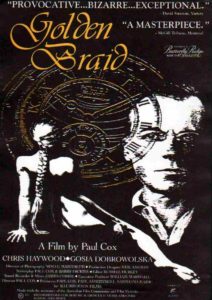 One of the strangest films ever made by Australia’s deeply idiosyncratic Paul Cox, who here spins a typically sexy and surreal account of a man in love with a braid of blond hair.
One of the strangest films ever made by Australia’s deeply idiosyncratic Paul Cox, who here spins a typically sexy and surreal account of a man in love with a braid of blond hair.
Inspired by Guy de Maupassant’s story “La Chevelure” (a.k.a. “A Tress of Hair”), the 1990 Australian-Canadian co-production GOLDEN BRAID suffered the fate of most Paul Cox films (which in addition to fairly well-known works like CACTUS, MAN OF FLOWERS and NIJINSKY include obscurities like KOSTAS, ISLAND and THE NUN AND THE BANDIT) in that it was barely released and quickly forgotten.
Bernard is a middle aged clockmaker and antique collector. He has many odd predilections, including his conviction that fixing up old things creates “new links between the living and the dead” and the fact that he only dates married women. His current lover is a married blond named Terese who’s much younger than Bernard, and who he treats as essentially a human antique, having her pose like the figures of his favorite paintings.
One day Bernard purchases an 18th Century cabinet and is immediately smitten with it. His obsession deepens when he pries open one of the drawers and discovers a disembodied braid of blond hair that belongs, apparently, to the cabinet’s long-dead former owner.
The golden braid comes to haunt Bernard’s dreams and fantasies. He keeps the braid hidden from Terese and ecstatically fondles, caresses, whispers to and masturbates with it whenever she’s not around. He even buys the braid a seat at a concert. In his all-consuming obsessiveness Bernard comes to neglect his business affairs and also Terese, who grows increasingly lonely and despondent.
Everything changes when Bernard’s cleaning woman finds the braid and blithely throws it away. Luckily Terese finally reveals her infidelity to her husband, and she and Bernard somehow live happily ever after.
Why is this film so little known? I’d say it’s too leisurely and refined for horror/cult movie fans yet too sexually frank for the MASTERPIECE THEATER crowd. The sexual angle isn’t present in the Maupassant source tale but is very much in keeping with the oeuvre of Paul Cox, who as usual includes much full-frontal nudity from both male and female performers. Other Cox trademarks include the extremely deliberate pacing, evocative use of wide shots and frequent intercutting of fantasies, dreams and flashbacks, visualized through varying formats.
In GOLDEN BRAID those things combine to create a languid and dreamlike atmosphere that’s entirely appropriate to the bizarre subject matter, which in lesser hands could easily have become freakish or pervy. I feel it’s one of Cox’s most accomplished films though also one of his most pretentious; much of the dialogue consists of poetic reveries about the nature of love and devotion, and the close-ups of the ticking clocks lining the protagonist’s house, with their gears, chimes and swinging pendulums, are over-utilized (being symbolic of the passage of time that Bernard so longs to reverse). Then there’s the ridiculous happy ending, which feels tacked-on and unsatisfying.
Vital Statistics
GOLDEN BRAID
The Australian Film Commission/Film Victoria
Director: Paul Cox
Producers: Paul Cox, Paul Ammitzboll, Samantha Naidu
Screenplay: Paul Cox, Barry Dickins
Cinematography: Nino G. Martinetti
Editing: Russell Hurley
Cast: Chris Haywood, Gosia Dobrowolska, Paul Chubb, Norman Kaye, Marion Heathfield, Monica Maughan, Robert Menzies, Jo Kennedy, Phillip Green, Sheila Florance, George Fairfax
